Geography of Iceland
| Native name: Ísland Nickname: Land of Fire and Ice | |
|---|---|
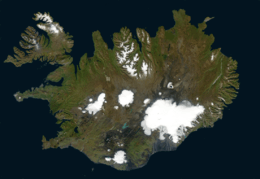 Satellite image of Iceland | |
.svg.png) | |
| Geography | |
| Coordinates | 65°00′N 18°00′W / 65.000°N 18.000°W |
| Adjacent bodies of water | Atlantic Ocean |
| Area | 103,001 km2 (39,769 sq mi) |
| Area rank | 18th |
| Coastline | 4,970 km (3,088 mi) |
| Highest elevation | 2,110 m (6,920 ft) |
| Highest point | Hvannadalshnúkur |
| Administration | |
| Largest settlement | Reykjavík (pop. 118,861) |
| Demographics | |
| Population | 330,000 (2015) |
| Pop. density | 3.3 /km2 (8.5 /sq mi) |
| Ethnic groups | Icelanders, Poles |
| Additional information | |
| Time zone | |
Iceland is an island country at the confluence of the North Atlantic and Arctic Oceans, east of Greenland and immediately south of the Arctic Circle, atop the constructive boundary of the northern Mid-Atlantic Ridge about 860 km (530 mi) from Scotland and 4,200 km (2,600 mi) from New York City. One of the world's most sparsely populated countries, Iceland's boundaries are almost the same as the main island – the world's 18th largest in area and possessing almost all of the country's area and population.
Geology
Iceland has extensive volcanic and geothermal activity. The rift associated with the Mid-Atlantic Ridge, which marks the division between the Eurasian Plate and North American tectonic plates, runs across Iceland from the southwest to the northeast. This geographic feature is prominent at the Þingvellir National Park, where the promontory creates an extraordinary natural amphitheatre. The site was the home of Iceland's parliament, the Alþing, which was first convened in 930. It is a common misconception that Þingvellir are at the juncture between the North American and Eurasian continental plates. However, they are in fact at the juncture of the North American continental plate and a smaller plate (approx. 10,000 km2) called the Hreppar Microplate (Hreppaflekinn).[1]
About half of Iceland's land area, which is of recent volcanic origin, consists of a mountainous lava desert (highest elevation 2,110 m (6,923 ft) above sea level) and other wasteland. Around 10.2 per cent of the total land area is covered by glaciers, although these are now retreating at an accelerating rate.[2] The four largest Icelandic glaciers are:
- Vatnajökull (7764 km²)
- Langjökull (868 km²)
- Hofsjökull (827 km²)
- Mýrdalsjökull (542 km²)
Other notable glaciers include:
- Drangajökull (145 km²)
- Eyjafjallajökull (70 km²)
- Tungnafellsjökull (33 km²)
- Þórisjökull (25 km²)
- Eiríksjökull (21 km²)
- Þrándarjökull (16 km²)
- Tindfjallajökull (11 km²)
- Torfajökull (10 km²)
- Snæfellsjökull (10 km²).
Twenty per cent of the land is used for grazing, while only 1 per cent is cultivated. Iceland has lost most of the woodland that previously covered large areas of the country, but an ambitious reforestation programme is currently underway.[3] Fossilized tree pollen and descriptions by the early settlers indicate that prior to human settlement, now thought to have occurred from around the year 800 onwards,[4][5] trees covered between 30 and 40 per cent of the island. Today, however, there are only small patches of the original birch forests left, the most prominent being Hallormsstaðaskógur and Vaglaskógur.
The inhabited areas are on the coast, particularly in the southwest, while the central highlands are all but uninhabited.
Because of the Gulf Stream's moderating influence, the climate is characterized by damp, cool summers and relatively mild but windy winters. Reykjavík has an average temperature of 12 °C (53.6 °F) in July and 1 °C (34 °F) in January[6] (Köppen: Cfc).
Statistics


- Location
- Island in North America (Commonly regarded as a part of Northern Europe), straddling the Eurasian and North American plates between the Greenland Sea and the North Atlantic Ocean, northwest of the British Isles.
- Geographic coordinates: 65°00′N 18°00′W / 65.000°N 18.000°W
- Extent (locations outside mainland in parentheses)
- North: Rifstangi, 66°32′3" N (Kolbeinsey, 67°08,9 N)
- South: Kötlutangi, 63°23′6" N (Surtsey, 63°17,7 N)
- West: Bjargtangar, 24°32′1" W
- East: Gerpir, 13°29′6" W (Hvalbakur, 13°16,6 W)
- Map references
- Arctic Region
- Area
- 39,769 sq miles (103,001 km²)
- Total: 103,125 km²
- Land: 100,329 km²
- Water: 2,796 km²
- Land boundaries
- 0 km
- Coastline
- 4,970 km
- Maritime claims
-
- Territorial sea: 12 nmi (22.2 km; 13.8 mi)
- Exclusive economic zone: 200 nmi (370.4 km; 230.2 mi)
- Continental shelf: 200 nmi (370.4 km; 230.2 mi) or to the edge of the continental margin
- Climate
- Temperate; moderated by North Atlantic Current; mild, windy winters; cool summers, damp in the south and west
- Terrain
- Mostly plateau interspersed with mountain peaks, icefields; coast deeply indented by bays and fjords
- Elevation extremes
-
- Lowest point: Jökulsárlón Lagoon: -146 m, Atlantic Ocean 0 m
- Highest point: Hvannadalshnúkur 2,110 m
- Natural resources
- Fish, hydropower, geothermal power, diatomite
- Land use
-
- Arable land: 1.21%
- Permanent crops: 0%
- Other: 98.79% (2012)
- Irrigated land
- NA
- Total renewable water resources
- 170 km3 (2011)
- Freshwater withdrawal (domestic/industrial/agricultural)
- Total: 0.17 km3/yr (49%/8%/42%)
- Per capita: 539.2 m3/yr (2005)
- Natural hazards
- Earthquakes, volcanic activity, avalanches, and glacial lake outburst flooding (or jökulhlaups)
- Environment—current issues
- Water pollution from fertilizer runoff; inadequate wastewater treatment
- Environment—international agreements
-
- Party to: Air Pollution, Air Pollution-Persistent Organic Pollutants, Biodiversity, Climate Change, Desertification, Endangered Species, Hazardous Wastes, Law of the Sea, Marine Dumping, Nuclear Test Ban, Ozone Layer Protection, Ship Pollution (MARPOL 73/78), Wetlands, Whaling
- Signed, but not ratified: Environmental Modification, Marine Life Conservation
- Geography—note
- Westernmost European country; more land covered by glaciers than in all of continental Europe
Antipodes
Iceland is not antipodal to any land mass. The closest are the Balleny Islands off Antarctica, claimed by New Zealand. The antipodes of the northernmost of these, Young Island, lie between Flatey and Grímsey Islands off the north central Icelandic coast, about 10 km from either.
Geological activity

A geologically young land, Iceland is located on both the Iceland hotspot and the Mid-Atlantic Ridge, which runs right through it. This location means that the island is highly geologically active with many volcanoes, notably Hekla, Eldgjá, Herðubreið and Eldfell
Iceland has many geysers, including Geysir, from which the English word geyser is derived.
With the widespread availability of geothermal power, and the harnessing of many rivers and waterfalls for hydroelectricity, most residents have access to inexpensive hot water, heating and electricity. See geothermal power in Iceland.
The island is composed primarily of basalt, a low-silica lava associated with effusive volcanism as has occurred also in Hawaii. Iceland, however, has a variety of volcanic types (composite and fissure), many producing more evolved lavas such as rhyolite and andesite. Iceland has hundreds of volcanoes with approx. 30 volcanic systems active.[7]
Maps and images
 True colour satellite image of Iceland in winter
True colour satellite image of Iceland in winter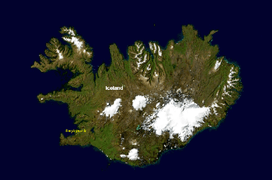 Satellite image of Iceland
Satellite image of Iceland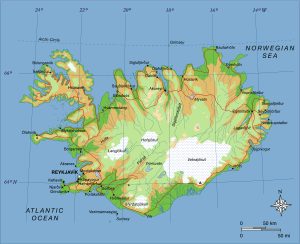 Map of Iceland showing major towns and geographical features
Map of Iceland showing major towns and geographical features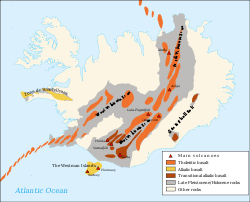 Active volcanic areas and systems in Iceland
Active volcanic areas and systems in Iceland Map showing the Mid-Atlantic Ridge splitting Iceland and separating the North American and Eurasian Plates
Map showing the Mid-Atlantic Ridge splitting Iceland and separating the North American and Eurasian Plates Ridge between the tectonic plates of Eurasia and North America
Ridge between the tectonic plates of Eurasia and North America Iceland is rich in sulfur deposits.
Iceland is rich in sulfur deposits.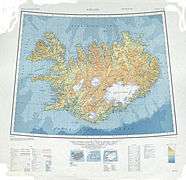 Topographic map of Iceland
Topographic map of Iceland
See also
- Extreme points of Europe
- Highlands of Iceland
- Iceland hotspot
- Iceland plume
- List of earthquakes in Iceland
- List of extreme points of Iceland
- List of fjords of Iceland
- List of islands of Iceland
- List of lakes of Iceland
- List of national parks of Iceland
- List of rivers of Iceland
- List of valleys of Iceland
- List of waterfalls of Iceland
References
- ↑ "Plate boundaries, rifts and transforms in Iceland" (PDF). JÖKULL No. 58, 2008. Institute of Earth Sciences, University of Iceland. Retrieved 19 March 2014.
- ↑ "Heildarstærð jökla á Íslandi 2014 (“Total surface area of Icelandic glaciers 2014”)" (PDF). Loftmyndir ehf. Archived from the original (PDF) on 17 March 2015. Retrieved 12 October 2015.
- ↑ "Forestry in a treeless land". Iceland Forest Service. Retrieved 12 October 2015.
- ↑ http://www.rae.ac.uk/submissions/ra1.aspx?id=187&type=hei&subid=3463
- ↑ "New View on the Origin of First Settlers in Iceland". Iceland Review Online. 4 June 2011. Retrieved 12 October 2015.
- ↑ "Mánaðarmeðaltöl fyrir stöð 1 – Reykjavík ("Monthly data for station No 1 – Reykjavík")". Retrieved 12 October 2015.
- ↑ Carmichael, I.S.E. (1964). "The Petrology of Thingmuli, a Tertiary Volcano in Eastern Iceland" (PDF). J. Petrology. 5 (3): 435–460. doi:10.1093/petrology/5.3.435.
External links
-
 Media related to Geography of Iceland at Wikimedia Commons
Media related to Geography of Iceland at Wikimedia Commons
